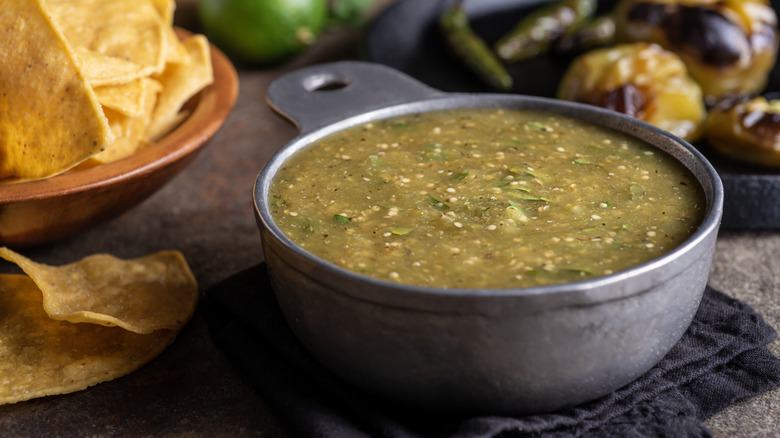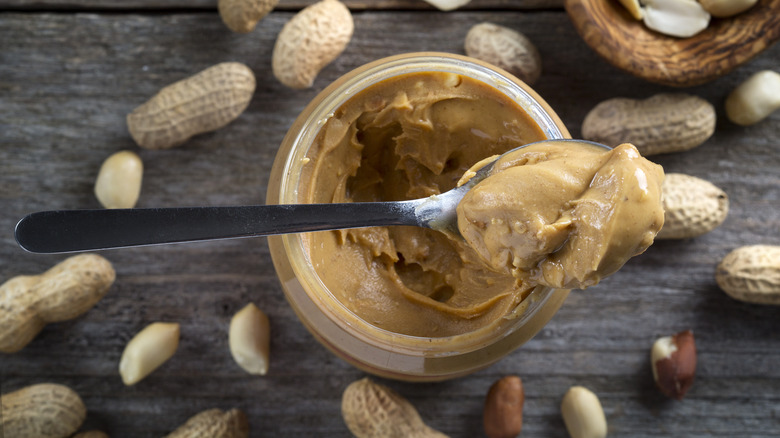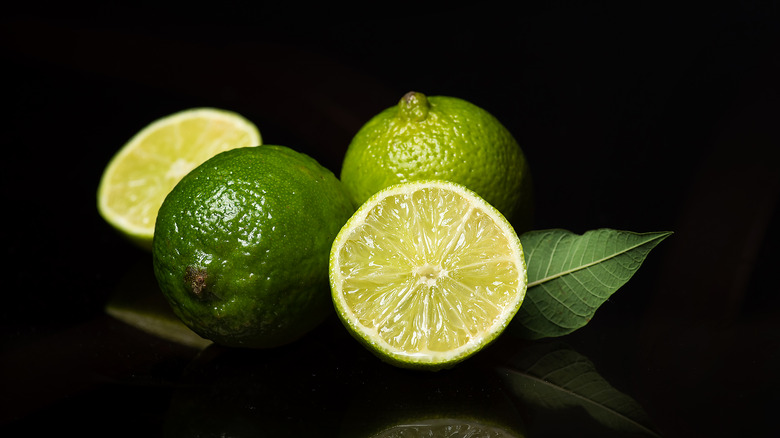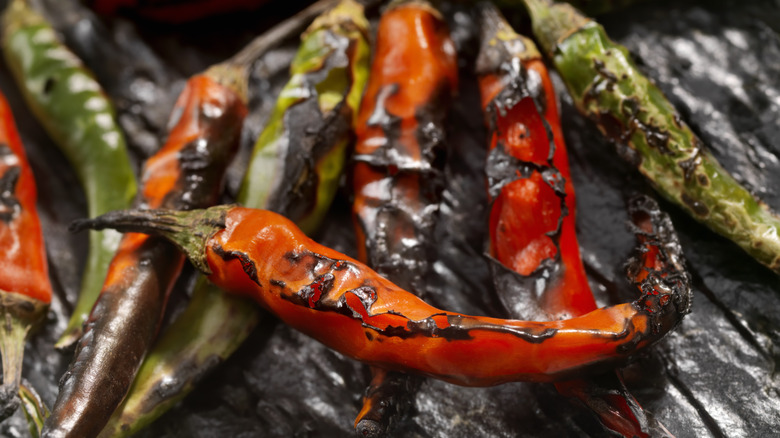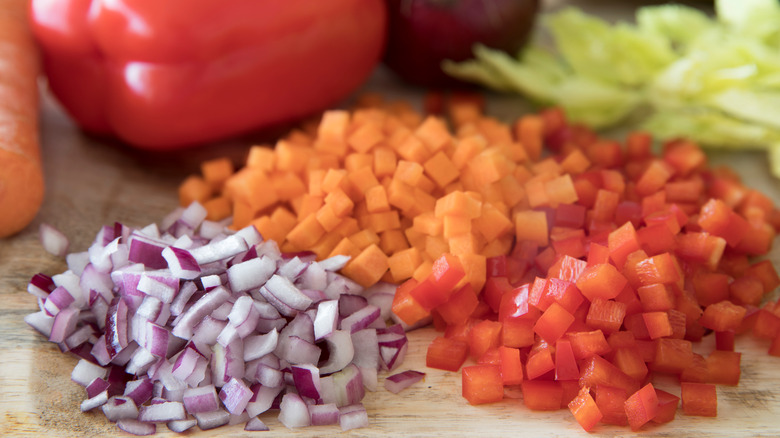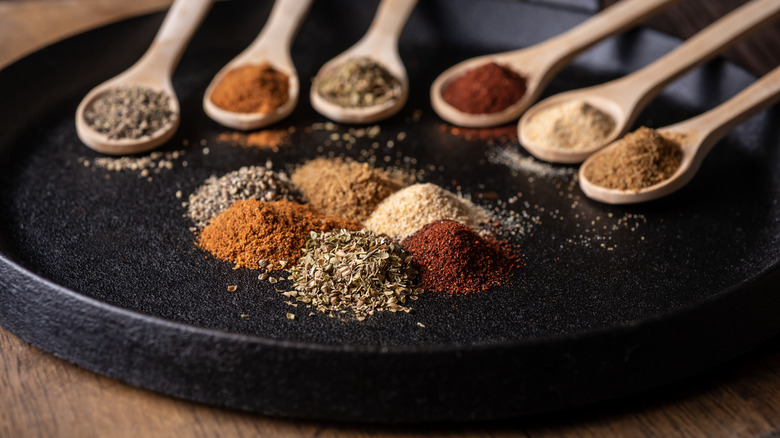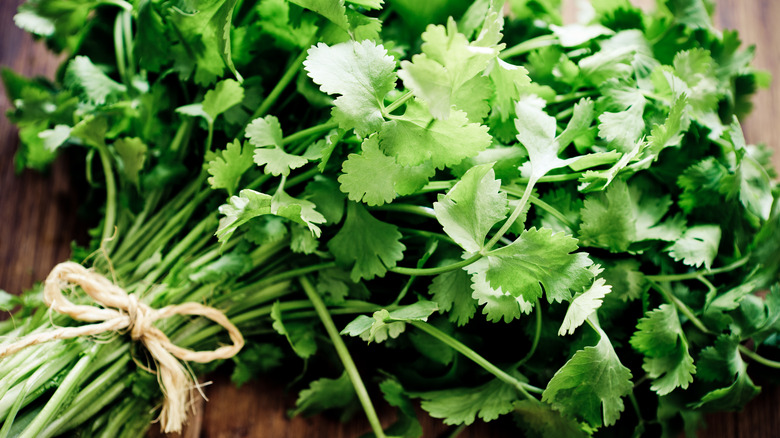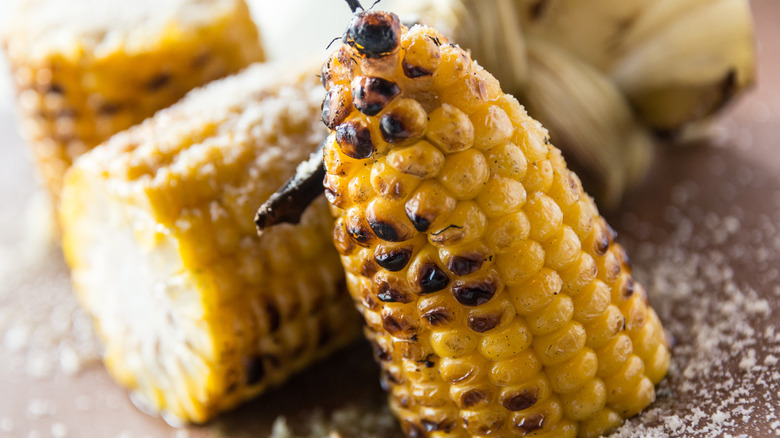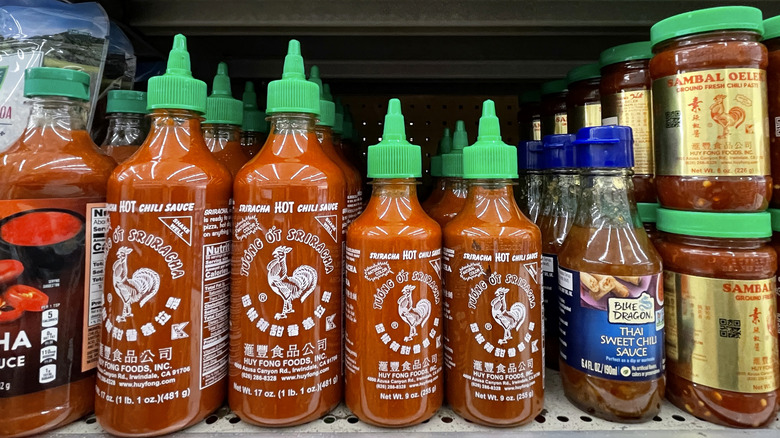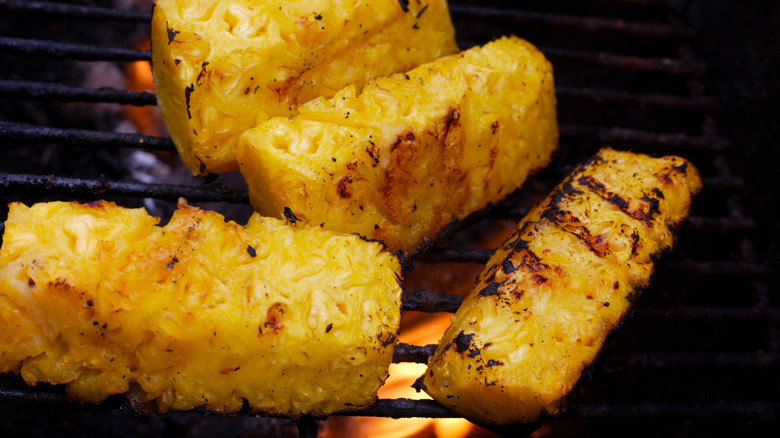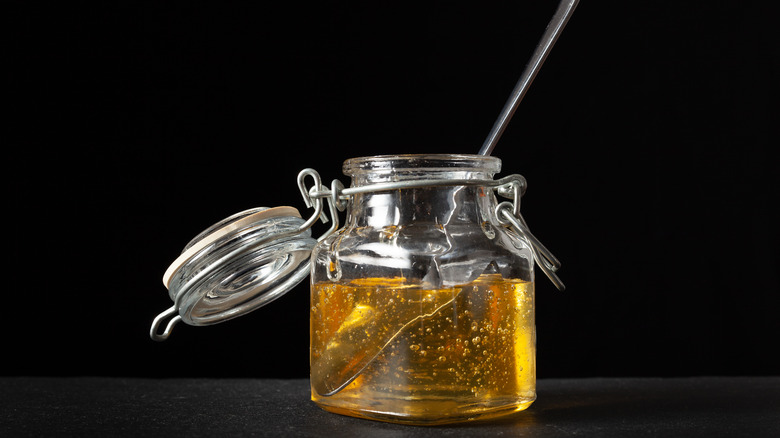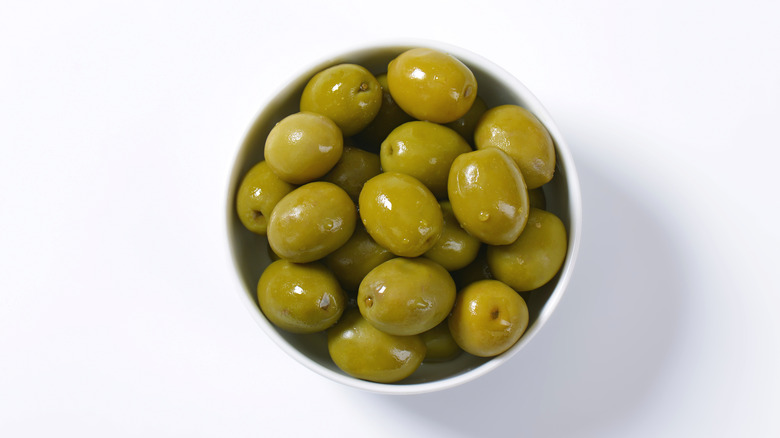11 Ways To Upgrade Store-Bought Salsa
To many, store-bought salsa just doesn't compare to homemade salsa or salsa that comes from good restaurants. But, sometimes you're in a hurry and you just don't have time to grab a great salsa recipe and make it from scratch. Or, maybe you have a jar of store-bought salsa that's been languishing at the back of your fridge and you need to use it up. For times like these, it's good to know how to upgrade store-bought salsa.
Yes, it came from the grocery store. And no, it may not be the most delicious salsa the world has to offer. But, with a simple upgrade or two, you can make the jarred stuff way tastier than you'd expect. There are all kinds of ways to give basic salsa a boost, from expected upgrades like herbs and lime juice to somewhat stranger options like nut butter and olives. Whether you go for the conventional or unexpected, every method on this list is delicious.
Upgrade your salsa with just one of these ingredients or combine a few complimentary upgrades to make the result extra special. With the right additions, you can make store-bought salsa taste almost as good as the best homemade stuff. Thanks to these simple upgrades, there's no need to get stuck eating subpar salsa again.
1. Stir in some nut butter
Let's start with an unusual upgrade: nut butter. This might sound strange, but stay with us. We know that stirring some nut butter through a basic tomato salsa will probably produce a clash of flavors that just isn't right. It's also a poor choice for green salsa or fruit salsa. However, it can work extremely well in spicy dried chile salsas and creamy bean salsas.
Nut butters bring a complex, rich flavor that can transform a boring store-bought bean dip or dried chile salsa into something you might dine on at a restaurant. Nut-based salsas like salsa macha are actually quite common in Mexican food; it's just that you won't find them on the shelves of many standard American grocery stores.
So, what types of nut butter work here? Basically, any of them — peanut butter, almond butter, and cashew butter are all prime contenders. You can also use any number of seed butters, like tahini or pumpkin seed butter. Each will bring a slightly different flavor, so take a moment to think about what you like and what the salsa you're upgrading could use. When you've made your decisions, just stir a tablespoon or two of nut or seed butter through your salsa of choice. If it ends up too thick, add some apple cider vinegar or lime juice to thin it out and help balance the flavors.
2. Add lime juice
The problem with store-bought salsa is that it can end up tasting muddy and one-note. That's far from the bright, vibrant salsas that you'd find in a good Latin American restaurant or that you might make from scratch. So, if you're looking for a simple way to upgrade a store-bought salsa, just add some lime juice.
Acidic lime juice cuts through other ingredients to brighten them up and can help to balance heaviness and add complexity to salsas that simply lack nuance. You can use lime juice in pretty much any kind of salsa; just don't add lime juice if your store-bought salsa is too acidic. So, try the salsa first to see what it needs. You can also try adding in the zest of a lime for an additional punch of citrus flavor without extra acid.
Don't have limes? You can also draw on other acidic ingredients. While lime is more common in salsa, lemon juice and even orange juice (ideally, squeezed directly from an orange, not from a carton) can work. You could also add a little rice vinegar or apple cider vinegar, but use it sparingly so as not to overwhelm the salsa and make it too acidic.
3. Char a pepper
Want to liven up your salsa with complex flavor and a spicy kick? Char a pepper and add it to the mix. You can use almost any chile pepper you can get your hands on, such as jalapeño, serrano, or relatively mild poblano varieties. Then, you need to char it. The quickest and easiest way is to hold the pepper over the flame of a gas burner, using tongs to get your hands at a safe distance. However, if you don't have a gas burner, you can also broil or roast the pepper in the oven until the skin starts to blister and blacken. Once that's done, you're ready to add the pepper to your store-bought salsa.
It's up to you whether you want to blend the charred pepper and stir that through your salsa or if you want to roughly chop it before mixing in to leave some texture intact. Either way, this method is a surefire way to improve your store-bought salsa. It works well in fruit salsa, too, so long as you like the sweet-spicy combo.
Whether you char just one pepper or multiple peppers depends on the quantity of salsa you're looking to upgrade, as well as your spice tolerance. If you like the idea of adding a smoky charred pepper flavor to your salsa but can't take the heat, you could do the same thing with a relatively sweet bell pepper.
4. Introduce crunchy vegetables
There are all kinds of ways in which basic grocery store salsa can be disappointing, and one of them is a lack of texture. Some salsa can be boringly smooth. Others might have chunks of ingredients, but those are annoyingly soft. Where's the crunch? If you want to level up a mediocre salsa, adding some texture via vegetables is a great idea.
All you need to do is chop some crunchy vegetables of your choice and stir them through the salsa, be it a tomato salsa, a too-heavy bean salsa, or practically any other type. If you're not sure what vegetables to use, options include bell peppers, cucumber, carrots, celery, and onion. Ultimately, it's dealer's choice here. Think about your preferences and the flavor profile of the salsa you're working with to select produce that won't get lost in the mix or mute other flavors.
As for size, some people like to opt for an extra-fine dice, while others prefer larger chunks. Of course, there's such a thing as too-large here: you don't want to chomp through huge chunks of carrot while trying to enjoy chips and salsa.
5. Make use of dried spices
One of the easiest, most accessible upgrades for store-bought salsa is the simple step of adding in some dried spices. If you cook at home, you probably already have a pantry full of them, so there's likely no need to go out and buy something new to pull this one off. Plus, spices are flavorful, so they can easily add a lot to salsa without much effort on your part. In the end, your salsa can taste way better, you won't have spent any money, and you will have barely put any time into the upgrade — what's not to like?
This method works for practically any type of salsa, whether it uses fruit, beans, tomatoes, dried chiles, corn, or more — all can be improved with the addition of some dried spices. Spices that work well include cumin, coriander, chili powder, and smoked paprika. You could even go a bit left-of-field with something like cinnamon or allspice. Some dried herbs work, too, such as oregano or even a touch of thyme.
You need to be careful when adding dried spices, though. Too much and the spices can dominate the flavor of your salsa. So, start with a small pinch, stir it in, and taste your salsa as you go. If it's not enough, add a small pinch more. Keep going until the balance of flavors is just right. Perhaps the best thing is the ability to easily experiment with flavors and create a beautifully complex salsa.
6. Add cilantro
Adding fresh herbs to your food can instantly level up dishes with very little effort. Putting cilantro in store-bought salsa is a great example of this rule in action. Cilantro is the obvious choice of herb, given that it's common in Mexican and other Latin American cuisines that produce all sorts of salsas as well. It's not like trying to add basil or parsley, which can be tasty in other dishes but may be odd in a salsa.
Simply chop some cilantro and mix it with your salsa. You could finely mince it if you don't want big pieces or you could roughly chop it if you're fine with a bit more texture and you're in a hurry. How much you add depends on how much you want the cilantro flavor to come through and how much salsa you're dealing with. To an average-sized jar, you could add anywhere from a tablespoon of cilantro to a small bunch.
Of course, know your audience: while some people like the bright taste of cilantro, others claim it's downright soapy. Yet, done right, the combination of fresh cilantro and a squeeze of lime is enough to liven up most tired grocery store options.
7. Roast or char corn
Corn can be the perfect addition to store-bought salsas. It works as an upgrade to the full gamut of salsa options, so you can pull out of the hat for almost any poor-quality salsa. But it's not enough to just put any old corn in the salsa you want to upgrade. It needs to be fresh and it also ideally needs to be roasted or charred.
Sure, you could roast your corn in the oven. You could also grill or broil cobs, or cook loose kernels in a hot skillet. Whatever your method, be sure that you get charred, browned, and blackened areas. This is where you'll gain the extra flavor you need to make subpar salsa a thing of the past. Correctly charred corn adds sweetness, smokiness, and a depth of flavor that most store-bought salsa is tragically lacking, as well as a hint of extra texture.
8. Splash in some hot sauce
Are you a spice fiend who finds most store-bought salsa to be too mild? Then what you need is a splash of hot sauce to kick things up a gear. The beauty of this upgrade is that it's almost suspiciously easy. Just grab your favorite hot sauce, shake in a few drops, stir it, and you're away. There's no need to chop, cook, or prep any ingredients.
You can add hot sauce to any variety of salsa that you think could do with some extra spice, and it also works well in conjunction with other simple upgrades. Few salsa-based problems can't be fixed with a dash of hot sauce, a bit of lime, and some dried spices.
Hot sauce can add more than just spice, as well. Some hot sauces are especially flavorful, lending sweet, smoky, herbaceous, or garlicky notes to your jarred salsa. Your choice of hot sauce can make a huge difference. The amount you should add depends on how much spice you want to add and how hot the sauce is. With some particularly spicy hot sauces, you'll only need a drop or two, while with milder hot sauces, you will probably want to be more generous. As with many other upgrades here, it's smartest to add a small amount and taste the result before adding any more.
9. Raid your fruit bowl
Adding fruit to your basic store-bought salsa can add flavor and complexity. However, you need to be thoughtful about the type of fruit you add. Mango, pineapple, and papaya, which are relatively strongly-flavored, are frequently fair game. However, if you tried to add strawberries or blueberries, their mild flavor may not play well with common salsa ingredients like onion or pepper. Neither are we about to slather apple or pear salsa all over our tacos.
While you can simply chop fruit and stir in through your salsa, you can add even more flavor by roasting, grilling, or charring fruit first. This can caramelize and concentrate the sugars for a more complex sweetness. Plus, any charred parts can add a smoky note, which gives the salsa even more deep, rich flavors.
If you decide you want to add fruit to your salsa, note that it works best for tomato and green salsas. Fruit generally isn't a particularly tasty addition to bean salsa or dried chile salsa, and fruit salsa probably doesn't need any extra fruit. But fruit salsas exist for a reason, so there's nothing wrong with adding certain fruits to your salsa in order to upgrade the result.
10. Add something sweet
Adding other sweet ingredients to store-bought salsa can help make it taste more like it's homemade. If you're new to cooking, it might seem a bit strange to add a sweetener to a savory food. After all, this is salsa, not a cookie recipe. But, good food is all about balance. A touch of sweetness balances sour, salty, and spicy notes to up the flavor ante.
Give your grocery store salsa a try and, if it tastes vinegary or overly acidic, some sweetness can help balance this out. It can also help when you know salsa is lacking something, but you aren't sure what. It might have a slightly metallic taste like canned tomatoes or maybe it just tastes boring and you aren't sure why. However, even if your salsa isn't noticeably unbalanced, a touch of sweetener can elevate things, especially if you like the combination of sweet and sour or sweet and spicy.
Now you know when to add something sweet, but what should you add? Sugar is an obvious choice, but it can be hard to dissolve into salsa, so liquid sweeteners are a better option. Agave nectar, honey, and even maple syrup can work here. This trick works especially well for tomato, green, and dried chile salsas.
11. Invite chopped olives and capers to the party
If you asked the average person whether they think olives and capers are good in salsa, they'd probably say "no." But, this is common practice in the Mexican state of Veracruz. There, you'll often find chopped olives and brined capers in tomato salsa. There's no reason why this can't work as an upgrade for store-bought salsa, too.
All you need to do is mince pitted green olives and capers in brine, then stir them through tomato-based salsa or salsa verde, where the briny flavor works especially well (it's not a good choice for other types of salsa, however). Dried spices, such as cumin and cinnamon, help boost the flavor even further.
What you get from this upgrade is brightness and complexity. It's a grown-up addition that elevates grocery store salsa way more than you'd think possible. It pairs well with tortilla chips but also anywhere else you might use salsa, such as on tacos and in burritos.
